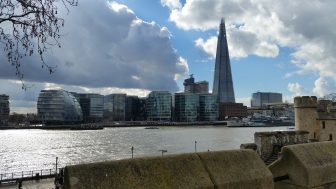The stamp duty holiday has unsurprisingly benefited London the most and had little impact in many other parts of the country, new figures show.
The number of agreed property sales in the capital has increased in recent months, helping to drive up prices in the city.
Residential property prices in London jumped at the end of last year, with average values breaking the £500,000 mark, according to official data.
Experts said the rise was driven in part by house hunters rushing to complete transactions before the stamp duty holiday deadline in March.
“The stamp duty holiday is a particular benefit in London and is likely to have played a significant part in this strong price growth, as the higher average house prices means that more stamp duty is typically due,” said PwC economist Jamie Durham.
On average in London buyers will save £10,514 on their move if they beat the deadline, research shows.
But there is obvious concern that property deals could collapse this spring as prospective buyers who have failed to exchange and complete by the end of the stamp duty holiday walk away.
Activity is expected to slow when the tax break ends on 31 March, and there is concern among many agents in the capital that some buyers who miss the deadline will pull out.
“The pressure to complete before the holiday ends is likely to be greatest where average values are around this level, such as in London,” said Lawrence Bowles, an analyst at Savills.
|
Rank |
Local authority |
Average house price |
Total stamp duty owed |
|
1 |
Kensington and Chelsea |
£1,507,130 |
£94,605 |
|
2 |
City of London |
£916,239 |
£35,811 |
|
3 |
City of Westminster |
£910,148 |
£35,506 |
|
4 |
Camden |
£840,770 |
£32,038 |
|
5 |
Hammersmith and Fulham |
£750,380 |
£27,518 |
|
6 |
Richmond upon Thames |
£707,773 |
£25,388 |
|
7 |
Islington |
£682,111 |
£24,105 |
|
8 |
Wandsworth |
£638,926 |
£21,945 |
|
9 |
Elmbridge |
£620,674 |
£21,033 |
|
10 |
Hackney |
£607,105 |
£20,354 |
|
11 |
Haringey |
£605,415 |
£20,270 |
|
12 |
Merton |
£571,988 |
£18,598 |
|
13 |
Lambeth |
£551,499 |
£17,574 |
|
14 |
Southwark |
£547,301 |
£17,364 |
|
15 |
Brent |
£540,086 |
£17,003 |
|
16 |
St Albans |
£533,281 |
£16,663 |
|
17 |
Three Rivers |
£531,874 |
£16,593 |
|
18 |
Barnet |
£526,127 |
£16,305 |
|
19 |
Kingston upon Thames |
£506,339 |
£15,316 |
|
20 |
Mole Valley |
£503,277 |
£15,163 |
|
Local authority |
Average house price |
|
Blackburn with Darwen |
£121,813 |
|
City of Kingston upon Hull |
£119,517 |
|
Stoke-on-Trent |
£119,109 |
|
Hartlepool |
£118,479 |
|
West Dunbartonshire |
£117,877 |
|
North Lanarkshire |
£116,565 |
|
Middlesbrough |
£116,488 |
|
Sunderland |
£116,393 |
|
North Ayrshire |
£116,314 |
|
Blackpool |
£115,280 |
|
Merthyr Tydfil |
£114,704 |
|
Pendle |
£113,915 |
|
Inverclyde |
£112,474 |
|
East Ayrshire |
£110,073 |
|
County Durham |
£109,980 |
|
Hyndburn |
£100,372 |
|
Burnley |
£99,409 |
|
Blaenau Gwent |
£95,002 |



Comments are closed.